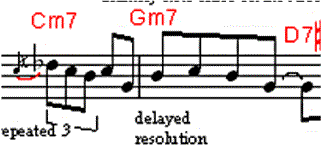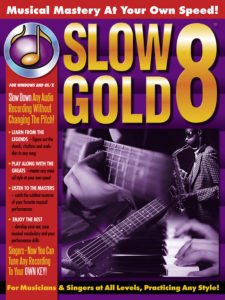Are You Learning Or Just Copying?
/in Improvising, Practice Techniques/by Warren SirotaSpending as much time as I do – enjoyable time, to be sure – transcribing and playing along with the solos by my musical idols of the moment, I sometimes have to stop and question whether I am making the best use of the (unfortunately) limited time I have for practicing.
To begin with, there is always the question of whether I should be writing instead of learning. The answer to that may well be “yes”, but I don’t seem to be in a writing mood these days – being a software developer and editor of Woodsheddin’ rarely leaves me with enough concentration for writing. But learning solos and licks is something I can do whenever I have a spare hour.
OK, but what do you do with those licks? Well, to be sure, I use them literally in performance as I play “Night and Day” a la Django or “Road Song” a la Wes. And you get several pure benefits just from doing the work of transcribing and practicing up to speed. The act of transcription extends your musical vocabulary. I often come away with a sense of “I didn’t know you could get away with that” after transcribing some killer-sounding passage that completely violates whatever harmonic logic I’ve absorbed through the years. It’s a liberating feeling, like being given permission to go beyond the world of formal rules about what’s right and wrong, and to play in the world of pure imagination. Even if emulating someone playing from that place doesn’t get you there, it reminds you that the place and the feeling exist.
Emulation is also great for your chops. Getting your fingers to move in patterns that are unfamiliar, often at challenging speeds, expands your physical capabilities and breaks you out of ruts. If your muscles evolve to where they are comfortable moving like Wes Montgomery (or Art Tatum or John Coltrane or Jimi Hendrix), then your spontaneous improvising is likely to drift in those directions on occasion. A gradual process of integrating new sounds and new approaches with your own playing style is bound to occur if you just play the new riffs enough and naturally listen more carefully to everything as you get deeper into one thing.
This article is about what we can do to consciously accelerate that kind of integration.
Mainly the process involves actually thinking about what I’m doing and, in a practice situation, extracting the essence of a riff (i.e., answering the question, “just what is it about this passage that appeals to me so much?”), and applying it in a new context. Well, gosh, this is suspiciously like work. And, in fact, it is work, but the rewards are substantial and lasting.
Let’s look at two examples for now: two little fragments of riffs, one from Wes and one from Django (also used by violinist Stephane Grappelli).
Interestingly enough, both of the examples that I am drawn to look at are essentially ornaments – ways of hitting a particular note that involve “beating around the bush” a little bit by trilling or slurring the adjoining notes before settling into the target. As all classical players know, ornaments are key elements of various musical styles. The way you play the ornament around a single note can determine whether you’re playing in a Renaissance, Baroque or Classical style – or, in our case, whether you sound like a bluesman or a gypsy.
Look at the first ornament, taken from the first turnaround of Wes’ Montgomery’s solo on Road Song, from the CD Jimmy & Wes, The Dynamic Duo (click here for more about the CD and the solo), shown here (the song is in Gm):

I was drawn to thinking about this element simply because it feels so good to play. If you’re playing in a jazz context, throwing this riff in just says “blues”. So, the question is, where does it work best? When should you use it?
Being the brute-force kind of experimenter guy that I am, I figured the best way to approach this would be to put a major and minor blues progression onto tape (well, actually I used an Echoplex, but that’s just ’cause it was convenient), to play phrases involving the ornament on top of it, and to see what works. And I made it even simpler for myself: I just played the first five notes (together with the grace note at the start). The phrase eventually, as I tried to apply it, got even shorter, until I was using just the first three notes (plus the grace note).
What I learned is simple: this sounds great practically in any part of a blues progression, major or minor, as long as you start on the fourth degree of the scale. So, in a Gm progression, start the trill on a C. In E, start in on A.
Oh yeah, there’s one other thing to keep in mind – although it’s great, during practice, to play the ornament a zillion times, wherever it fits (or even where it doesn’t fit), you should use it far more sparingly when actually performing. If you sneak it in a few times (or even just once!) in an evening, it can add a bit of spice without becoming a cliche.
By the way, another key stylistic element of Wes’ playing that I discovered while transcribing and analyzing is the fact that he almost always uses a half-note interval when sliding into an octave from below – almost never a whole step or other interval. And he does quite a bit of this sliding.
A Site For Beginning Guitarists and Uke-ists (Ukelists? Ukelelists?)
/in Practice Techniques, Tools/by Warren SirotaHi,
I know a lot of the posts here on slowgold.com are for kind of advanced players, but if you’re kind of new to the world of guitars (or ukuleles), let me commend you to https://coustii.com, where you will find a lot of information geared to you: How to pick an instrument, basic chords, some easy songs and the like. Enjoy!
–Warren
Convert .aac Files To .mp3 In Order To Drag Into SlowGold
/in Support/by Warren SirotaBy default, Apple iTunes imports files in AAC file formats. If you try to drag one of these files into SlowGold, you will get a stop sign that says you can’t do this. This can be fixed by using iTunes itself to make an mp3 copy of the file – just follow the instructions that we’ve posted here.
Practice Tips: Pushing past your physical limits
/in Practice Techniques/by Warren SirotaSuppose you have a melodic phrase (or any other kind of passage) that you’re trying to learn that is giving you trouble. I’ve encountered plenty of these transcribing Django Reinhardt guitar parts with SlowGold. Figuring out what notes he’s playing is only half the battle for me – the man just plays so darn fast. So it’s a lot of work to actually get those phrases under my less-than-light-speed fingers. But I’m trying, and gradually succeeding. I feel the effort is worthwhile. Not only is my dexterity improving, but I’m getting a whole bunch of new shapes and habits into the “muscle memory” (more about this later) of my hands, which is where they have to be in order to be useful when I play on the gig or with other people.
Start Slow, Be Patient With Yourself, and Trust Your Body
You probably already know that the first step in learning a new passage is to play it along with a metronome set to a really slow speed (well, sometimes you have to stumble through the passage a few times before you can even do that – if even playing the passage at a really slow metronome setting is too difficult, see the section on Isolation below). You should hunt for the highest metronome setting at which you can play the passage comfortably, with good tone, and without errors several times in a row. Once you’ve found that setting, increase it a notch or two, until you have a setting which is just on the edge of your ability. You should be able to play the passage if you really concentrate and try.
Play the passage over and over again at this “edge of your ability” speed – for 5 to 15 minutes is what I usually do. If it’s physically painful in any way, stop immediately and pick it up again in a few hours or the next day. What usually happens for me is the opposite, however; the “edge speed” becomes comfortable fairly quickly, and I notch up the metronome further.
One note about metronome “notches” – if you’re playing a passage with one note per metronome beat, you may have to go several settings higher on the device before you notice much of a difference. On the other hand, if you’re playing 16th notes (4 per click), then a single metronome notch up might make a significant difference in difficulty.
You’ll probably notice that the very first time you try to play a passage with the metronome you may have to play it very slowly; yet, after the passage gets “into your hands” you’ll be able to make a big jump in speed. This phenomenon is known in some circles as muscle memory, and is indicative that your nerve pathways have actually been reprogrammed by your repetitive activity to take over some of the control from your conscious mental process. This is a good thing. A large part of the point of practice is, in my opinion, to reprogram the neural pathways.
This phenomenon will undoubtedly be evident the day after your first session with a new riff. You’ll set the metronome at a comfortable setting, and it will be significantly higher than the initial setting. You will be much more comfortable with the passage, to a degree that may surprise you.
Increasing your physical dexterity simply requires patience and repetition. You can’t force your pathways to learn any faster than they want to. Others may learn faster than you, but it’s not your fault, as long as you put in the time. Your body is your body, not their body, and there’s nothing you can do about that. Don’t try to play a passage much faster than your abilities dictate in an attempt to break over a hurdle – it’s just not gonna happen, and you’ll be wasting your time and increasing your frustration. And take breaks – 15 minutes is a really long time to work on a single passage and should be the absolute upper limit. Several short sessions each day are probably superior to one long one.
Above all, have faith. Follow this program and improvement is inevitable. It may not be at the pace you desire, but it will occur. Just keep at it.
Keep A Practice Log
I like to make note of the metronome settings and the date next to each passage I’m working on. This helps me track my progress. Click here to access a free practice log template that you can print out and use.
Put Variety Into Your Practice Sessions
Don’t just practice one riff. It’s boring. Music is supposed to be fun, remember? In fact, don’t just practice riffs. Depending on the time you have available, try to increase your musical abilities in many areas. Set aside some time each day or week to write or create something. Learn new tunes. Study music theory and ear training books. Learn new riffs from records (using SlowGold, of course). Create new riffs based on ones you know. Everything you do to increase your physical and mental skills is valuable.
Don’t Be Afraid Of Backtracking
Some day you will notice that, although you’ve gradually goosed up the metronome to a pretty nice clip, what you’re playing is sounding sloppy or inadequate in some way. So bring the metronome back down and start re-practicing the passage with the higher standards that you’ve subconsciously developed in mind. It’s a good thing. Don’t try to rush your development. After all, when do you have to have this process done by? Never! (at least in most cases). It’s a Zen thing.
Observe Yourself
Listen carefully to what you’re playing. Is your tone good throughout? Where are the awkward points (this will bring us to Isolation, below)? Could you be fingering the passage in a more efficient manner? Are you sitting with proper posture? Are you holding tension that doesn’t need to be there in your hand? In your jaw? Any such tension detracts from your performance by sending bodily energy into unproductive and restrictive uses.
I have found that, with guitar parts, where I put my attention can make a huge difference – and in surprising ways. Some passages that I thought were tricky because of my right hand ended up being easier to play when I focussed on my left hand during practice, and vice versa! I still don’t understand it, except as an indication that sometimes my own beliefs as to what are the stumbling blocks may not be accurate. Weird.
Play With Your Eyes Closed
You may have to slow down the metronome considerably to do this, but it really is liberating not to have to look at your hands while you’re playing.
Isolation
In this troubled and fragmented world, you’d think that the last thing you’d want more of is isolation. But, in fact, isolation is a tremendously valuable tool for musicians trying to increase their physical skills.
I’ll be discussing two forms of isolation– the isolation and smoothing of trouble spots in difficult phrases (for all musicians) and left/right hand isolation for guitarists.
If you’re having difficulty with a phrase, try and identify the trouble spots. If they’re not obvious, just break the phrase in half and see which half is harder to play than the other. Keep breaking it up into smaller fragments and practicing them individually.
Once you’ve mastered a fragment of the phrase, the next step is to master the approach and exit from the fragment. Add a couple of notes before the fragment. Does it get harder? If so, practice the new, enlarged fragment for a while before adding more notes. You may have to slow down in order to incorporate the new part. Then add notes at the end. Continue this process until you’ve mastered the phrase.
Guitarists, and possibly other musicians, should also experiment with left/right hand isolation. My Django studies have forced me to develop a form of picking known as “sweep picking” in the right hand, in both ascending and descending patterns (left-handed guitarists: reverse everything I say in the next couple of paragraphs). I’m quite used to and facile with “alternating picking”, which is where the pick goes down for one note and up for the next. In contrast, in sweep picking, notes on adjacent strings are played with the same direction of pick motion.
This is a major shift for me. Normally, I’m fairly unconscious about my right hand, focussing attention instead on the left. But recently, I’ve found it very helpful to practice the right hand parts of the run only. I pick as though I’m playing the phrase, but I simply hold my left hand over the strings, damping them, instead of actually fretting the notes. After a few run-throughs in this manner, I usually have a much better handle on the piece.
Practice Everywhere
You do not have to be at your instrument in order to practice! Whenever you’re bored (but not while you’re driving a vehicle or operating heavy machinery – this is an intense exercise), visualize your fingers (and/or hands and feet) doing exactly what they would be doing if you were at your instrument. Start slowly and precisely, and then ramp up the speed – but never lose the precision of your vision! You’ll be amazed at how much of your physical difficulty may stem from an inadequate mental concept of the passage, and how much difference it can make in your playing.
It’s a Zen Thing
Don’t always be pushing the speed. In fact, it’s a good idea to settle in at a tempo just under your peak speed and play the passage over and over, concentrating on reaching a state of focused relaxation while the tone gets cleaner and cleaner. Do it for five minutes and let the tension seep out of your muscles.
In Conclusion
So, those are my practice tips for this issue of Woodsheddin’. If you have more of your own, e-mail them to wsirota@worldwidewoodshed.com and I’ll include them in a future issue, credited to you. Thanks for reading and playing!
Using iTunes to Convert Audio Formats
/in Tools/by Warren SirotaSometimes you have a .wav or .aiff file, and you want it in .mp3 format. SlowGold, for instance, exports audio in these formats if you choose to save a slowed-down song or a segment of such a song. SlowGold does not, however, write mp3 files because of the prohibitive license costs for doing this directly (it reads and plays mp3s perfectly well, of course).
Apple, however, is not constrained the way we are when it comes to mp3 writing, and iTunes can convert between formats, although the functionality is somewhat hidden.
The current instructions for the conversions are at https://support.apple.com/en-us/HT204310. Enjoy!

